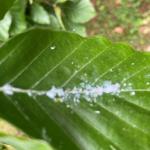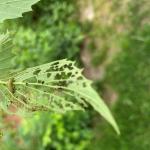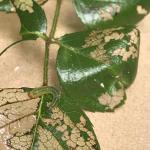UMass Extension's Landscape Message is an educational newsletter intended to inform and guide Massachusetts Green Industry professionals in the management of our collective landscape. Detailed reports from scouts and Extension specialists on growing conditions, pest activity, and cultural practices for the management of woody ornamentals, trees, and turf are regular features. The following issue has been updated to provide timely management information and the latest regional news and environmental data.
The Landscape Message will be updated weekly in June. The next message will be posted on June 10. To receive immediate notification when the next Landscape Message update is posted, be sure to join our e-mail list
To read individual sections of the message, click on the section headings below to expand the content:
Scouting Information by Region
Environmental Data
The following data was collected on or about June 1, 2022. Total accumulated growing degree days (GDD) represent the heating units above a 50° F baseline temperature collected via regional NEWA stations (http://newa.cornell.edu) for the 2022 calendar year. This information is intended for use as a guide for monitoring the developmental stages of pests in your location and planning management strategies accordingly.
|
MA Region/Location |
GDD |
Soil Temp |
Precipitation |
Time/Date of Readings |
|||||
|
1-Week Gain |
2022 Total |
Sun |
Shade |
||||||
|
CAPE |
104 |
292 |
63 |
61 |
0.34 |
12:00 PM 6/1 |
|||
|
SOUTHEAST |
113 |
394 |
69 |
63 |
0.15 |
3:00 PM 6/1 |
|||
|
NORTH SHORE |
103 |
332 |
64 |
58 |
0.37 |
10:00 AM 6/1 |
|||
|
EAST |
114 |
441 |
61 |
57 |
0.49 |
4:00 PM 6/1 |
|||
|
METRO |
108 |
413 |
63 |
59 |
0.22 |
5:30 AM 6/1 |
|||
|
CENTRAL |
110 |
401 |
65 |
61 |
0.47 |
7:30 AM 6/1 |
|||
|
PIONEER VALLEY |
114 |
428.5 |
68 |
63 |
0.42 |
12:00 PM 6/1 |
|||
|
BERKSHIRES |
103 |
351 |
69 |
62 |
0.84 |
7:00 AM 6/1 |
|||
|
AVERAGE |
108.5 |
382 |
65 |
61 |
0.41 |
_ |
|||
|
* = information not available |
|||||||||
As of 5/31, most of our state is in either a "Moderate Drought" or classified as "Abnormally Dry": Massachusetts | U.S. Drought Monitor (unl.edu)
Phenology
| Indicator Plants - Stages of Flowering (BEGIN, BEGIN/FULL, FULL, FULL/END, END) | ||||||||
|---|---|---|---|---|---|---|---|---|
| PLANT NAME (Botanic / Common) | CAPE | S.E. | N.S. | EAST | METRO W. | CENT. | P.V. | BERK. |
|
Kalmia latifolia (mountain laurel) |
Begin |
* |
Begin |
Begin |
* |
Begin |
Begin/Full |
* |
|
Cotinus coggygria (common smokebush) |
* |
Begin |
Begin |
* |
Begin |
Begin |
Begin |
* |
|
Weigela florida (old fashioned weigela) |
Full |
Full |
Full |
Full |
Full |
Full |
Full |
Full |
|
Robinia pseudoacacia (black locust) |
Begin/Full |
End |
Full |
Full |
Full |
Full |
Full |
Begin/Full |
|
Syringa meyeri (Meyer lilac) |
Begin/Full |
End |
Full |
Full |
Full |
Full |
Full |
Full |
|
Deutzia spp. (deutzia species) |
Full |
End |
Full |
Full |
* |
* |
Full/End |
Begin/Full |
|
Aesculus hippocastanum (common horsechestnut) |
Full |
End |
Full/End |
Full |
Full/End |
Full/End |
Full/End |
Full |
|
Enkianthus campanulatus (redvein enkianthus) |
Begin/Full |
* |
Full |
Full |
Full |
Full |
Full |
Full |
|
Rhododendron carolinianum (Carolina rhododendron) |
Full/End |
Full/End |
Full/End |
Full/End |
Full/End |
Full/End |
Full/End |
Full/End |
|
Rhododendron catawbiense (catawba rhododendron) |
Full |
Full |
Full/End |
Full/End |
Full/End |
Full/End |
Full/End |
Full |
|
Spiraea x vanhouttei (Vanhoutte spirea) |
Full/End |
End |
End |
End |
End |
End |
End |
Full |
| * = no activity to report/information not available | ||||||||
Regional Notes
Cape Cod Region (Barnstable)
General Conditions: The average temperature for the period from May 25 thru June 1 was 62ºF with a high of 84ºF on May 31 at 9:00am and a low of 42ºF on May 26. There was a mix of cloudy, partly cloudy and sunny days during the period. Precipitation fell on May 27, 28, 31 and June 1, though only amounting to a total of a third of an inch. The US Drought Monitor has the Cape listed as abnormally dry again this week. Soil moisture is short. Unirrigated turf growth is slow for the time of year as a result of low soil moisture and beginning to show some drought stress. The cool, cloudy days recently are helping reduce some of the soil moisture stress. Some herbaceous plants seen in bloom include bearded iris (Iris germanica), Siberian iris (Iris sibirica), columbine (Aquilegia spp), lupines (Lupinus spp.), bloody/red wild geranium (Geranium sanguineum), chives (Allium schoenoprasum), foxglove (Digitalis purpurea), peony (Paeonia lactiflora), catmint (Nepeta spp.) and false blue indigo (Baptisia australis). Some woody plants seen in bloom include azaleas, rhododendrons, holly (Ilex opaca), many viburnums (Viburnum plicatum, V. cassinoides, V. dentatum, V. opulus) and sheep laurel (Kalmia angustifolia). Pollen is abundant coming from various main sources, switching from oaks to pines and cool season grasses.
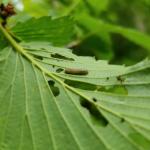
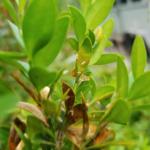
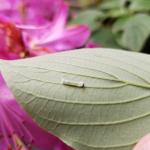 Pests/Problems: A couple more cases of Beech Leaf Disease (BLD) were reported this past week, primarily in the upper Cape region. BLD is something to keep an eye out for and to be sure to report it. Winter moth feeding is coming to an end; holes in leaves of many tree and shrub species are visible, however the damage does not threaten plant health. Turpentine beetle is active, viburnum leaf beetle was observed in arrowwood viburnum, rose slug sawfly larvae were observed on rose, dogwood sawfly larvae were seen feeding on alternate leaf dogwood, boxwood leafminer midges are active and still emerging from old leaves, aphids were spotted on numerous herbaceous plants and eastern tent caterpillar was observed on black cherry. Disease symptoms or signs observed during the period include needlecast on pitch pine, white pine needle disease on white pine, tip blight on eastern red cedar and Leyland cypress, branch dieback on Leyland cypress, anthracnose on sycamore, brown rot on ornamental cherries, cedar apple rust galls active on eastern red cedar, volutella blight on boxwood, basil downy mildew on basil, and red thread in turf. Black swallowwort (Cynanchum louiseae, Vincetoxicum nigrum) is beginning to bloom. Other weeds and invasive plants in bloom include cypress spurge (Euphorbia cyparissias), white clover (Trifolium repens), red clover (Trifolium pratense), narrowleaf plantain (Plantago lanceolata), creeping buttercup (Ranunculus repens), black medic (Medicago lupulina), and several species of speedwell (Veronica spp.). Bush honeysuckles (Lonicera spp.) and autumn olive (Elaeagnus umbellate) are ending bloom. Rabbit and slug damages were observed. Ticks are everywhere – keep yourself protected.
Pests/Problems: A couple more cases of Beech Leaf Disease (BLD) were reported this past week, primarily in the upper Cape region. BLD is something to keep an eye out for and to be sure to report it. Winter moth feeding is coming to an end; holes in leaves of many tree and shrub species are visible, however the damage does not threaten plant health. Turpentine beetle is active, viburnum leaf beetle was observed in arrowwood viburnum, rose slug sawfly larvae were observed on rose, dogwood sawfly larvae were seen feeding on alternate leaf dogwood, boxwood leafminer midges are active and still emerging from old leaves, aphids were spotted on numerous herbaceous plants and eastern tent caterpillar was observed on black cherry. Disease symptoms or signs observed during the period include needlecast on pitch pine, white pine needle disease on white pine, tip blight on eastern red cedar and Leyland cypress, branch dieback on Leyland cypress, anthracnose on sycamore, brown rot on ornamental cherries, cedar apple rust galls active on eastern red cedar, volutella blight on boxwood, basil downy mildew on basil, and red thread in turf. Black swallowwort (Cynanchum louiseae, Vincetoxicum nigrum) is beginning to bloom. Other weeds and invasive plants in bloom include cypress spurge (Euphorbia cyparissias), white clover (Trifolium repens), red clover (Trifolium pratense), narrowleaf plantain (Plantago lanceolata), creeping buttercup (Ranunculus repens), black medic (Medicago lupulina), and several species of speedwell (Veronica spp.). Bush honeysuckles (Lonicera spp.) and autumn olive (Elaeagnus umbellate) are ending bloom. Rabbit and slug damages were observed. Ticks are everywhere – keep yourself protected.
Southeast Region (Dighton)
General Conditions: Onshore winds have kept temperatures cool but we still have not had any significant precipitation. Soils are becoming very dry indeed. Herbaceous plants are showing midday wilt, unirrigated lawns are already drought stressed and lawn areas in full sun are prematurely dormant due to drought. Monarch butterflies have arrived and eastern tiger swallowtail butterfly adults are about. Crane fly adults are being observed even as hummingbirds are searching for nectar. Cottonwood 'lint' is blowing on every wind. Plants seen in flower include: Achillea millefolium (yarrow), Baptisia australis (blue indigo), Coreopsis spp. (tickseed), Cornus kousa (Chinese dogwood), Chionanthus retusus (Chinese fringetree), Cytisus scoparius (Scotch broom), Dasiphora fructiosa/Potentilla fructiosa, (shrubby cinquefoil), Dianthus spp. (pinks), Digitalis lutea (yellow foxglove), Galium aparine (bedstraw, cleavers), Geranium sanguineum (bloody crane's bill), Hemerocallis 'Stella d'oro' (early yellow daylily), Hieracium pilosella (yellow hawkweed), Iris germanica (bearded iris), I. pseudacorus (yellow flag), I. siberica (Siberian iris), Leucanthemum x superbum (Shasta daisy), Linnaea amabilis/Kolkwitzia amabilis (beauty bush), Lonicera caprifolium (perfoliate honeysuckle), Papaver oriental (oriental poppy), Physocarpus opulifolius (ninebark), Rubus (brambles), Sedum stenopetalum (golden constellation stonecrop), Viburnum dentatum (arrowwood), and weigela.
Pests/Problems: White pine are releasing prodigious, billowing clouds of sticky pollen which is covering every surface with a yellow-green cast and causing those so disposed to manifest itchy weeping eyes and violent sneezing. It's early in the season to be so very dry. When summer temperatures finally arrive, the effects will be devastating unless we have some significant rains soon. (See drought monitor link above, just below the environmental data chart.)
North Shore (Beverly)
General Conditions: Another week of dry weather with mostly clear skies. The North shore area is now under moderate drought. Approximately 0.37 inches of rainfall was recorded at Long Hill during this reporting period. The weather was very comfortable for outdoor work except on Monday, May 30 when there were some rain showers in the area. Temperatures were much warmer compared to the previous week. Daytime temperatures ranged from mid 50s to mid 80s and nighttime temperatures ranged from mid 50s to low 60s. The average daily temperature was 65ºF with the highest temperature of 86ºF recorded on May 30 and the lowest temperature of 50ºF recorded on May 26. Due to the brief showers and cool weather, especially during the night, grass is looking good on lawns. Woody plants seen in bloom include: Chinese Neillia (Neillia sinensis), white Japanese wisteria (Wisteria floribunda longissima alba), slender deutzia (Deutzia gracilis), fringe tree (Chionanthus virginicus), doublefile viburnum (Viburnum plicatum var. tomentosum), beautybush (Kolkwitzia amabilis), kousa dogwood (Cornus kousa), mock orange (Philadelphus spp.), mountain laurel (Kalmia latifolia), and some azalea varieties. Some of the non-woody plants seen in bloom include: fetterbush (Leucothoe fontanesiana), Scotch rose (Rosa spinosissima), peony (Paeonia spp.), cranesbill (Geranium spp.), bleeding heart (Dicentra spectabilis), Solomon’s seal (Polygonatum odoratum), blue star (Amsonia hubrichtii), and several annuals.
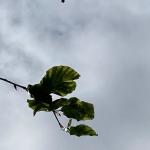

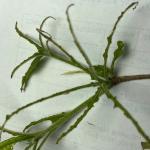
 Pests/Problems: Potential beech leaf disease was observed on a beech tree in Essex County. Also noted was woolly beech aphid. Boxwood psyllid was observed on several boxwood plants. Leaf and flower gall disease (Exobasidium vaccinii) was found on azalea. The fungus causes cells in leaf and flower tissue to multiply rapidly forming large fleshy galls. The disease can be controlled by hand picking the galls and burning or burying them. To prevent new infections, pick the galls now before the white spore layer appears. Azalea sawfly was also observed causing serious damage on some azaleas. They are completely defoliating azaleas leaving only the leaf veins.The larvae are small, green with tan heads and are difficult to see because they blend very well with the expanding leaves. Application of spinosad (Conserve), pyrethroids or any other labeled insecticide can provide effective control. Also observed was cherry sawfly. The larvae are small, olive green and about 0.35 inches long. Larvae feed on the upper surface of leaves, skeletonizing them. Viburnum leaf beetles continue to enlarge and are skeletonizing the leaves of American cranberrybush viburnum and arrowwood viburnum. Rose slug sawfly is continuing to cause damage on some rose bushes. Mosquitoes and ticks continue to be very active. Protect yourself with a repellent when working outdoors.
Pests/Problems: Potential beech leaf disease was observed on a beech tree in Essex County. Also noted was woolly beech aphid. Boxwood psyllid was observed on several boxwood plants. Leaf and flower gall disease (Exobasidium vaccinii) was found on azalea. The fungus causes cells in leaf and flower tissue to multiply rapidly forming large fleshy galls. The disease can be controlled by hand picking the galls and burning or burying them. To prevent new infections, pick the galls now before the white spore layer appears. Azalea sawfly was also observed causing serious damage on some azaleas. They are completely defoliating azaleas leaving only the leaf veins.The larvae are small, green with tan heads and are difficult to see because they blend very well with the expanding leaves. Application of spinosad (Conserve), pyrethroids or any other labeled insecticide can provide effective control. Also observed was cherry sawfly. The larvae are small, olive green and about 0.35 inches long. Larvae feed on the upper surface of leaves, skeletonizing them. Viburnum leaf beetles continue to enlarge and are skeletonizing the leaves of American cranberrybush viburnum and arrowwood viburnum. Rose slug sawfly is continuing to cause damage on some rose bushes. Mosquitoes and ticks continue to be very active. Protect yourself with a repellent when working outdoors.
East Region (Boston)
General Conditions: Daytime temperatures averaged 78ºF over the past week reaching a high of 87ºF on May 30. Overnight lows averaged 55ºF with a low of 45ºF on May 25. We received 0.49 inches of precipitation with a significant 0.46 inches falling on May 28. The landscape is full of color with an abundance of trees, shrubs and perennials in bloom. Some plants in bloom include: Baptisia australis (false blue indigo), Chionanthus virginicus (white fringe tree), Cytisus scoparius (Scotch broom), Laburnum x watereri ‘Vossii’ (golden chain tree), Liriodendron tulipifera (tulip tree), Papaver orientalis (oriental poppy) and Philadelphus spp. (mock orange). 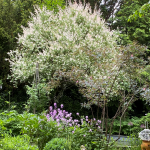 Standing out in the landscape is the underutilized dappled willow (Salix integra ‘Hakuro Nishiki’) with its newly emerging white/pink tipped foliage appearing as if it were in flower.
Standing out in the landscape is the underutilized dappled willow (Salix integra ‘Hakuro Nishiki’) with its newly emerging white/pink tipped foliage appearing as if it were in flower.
Pests/Problems: We are still in moderate drought conditions, but the half inch over the past week and more predicted over the next few days, may help to alleviate the situation. Landscape weeds in bloom include: cow parsley (Anthriscus sylvestris), greater celandine (Chelidonium majus), mouse ear chickweed (Cerastium fontanum) and pineapple weed (Matricaria discoidea). Crabgrass (Digitaria spp.) has germinated. Turf weeds such as creeping buttercup (Ranunculus repens), ground ivy (Glechoma hederacea), star of Bethlehem (Ornithogalum umbellatum) and violets (Viola spp.) continue to invade unmanaged turf. Japanese knotweed (Polygonum cuspidatum) has undergone a growth spurt and is six feet tall along roadways.
Metro West (Acton)
General Conditions: Memorial Day is behind us which means the so-called unofficial start to the summer has begun and the day kicked the season off for us appropriately with a summer-like high temperature of 88ºF recorded! There was little precipitation recorded during this week with a total of 0.22” measured. The average monthly rainfall for May is 4.04” and we closed the month with only 0.82” of rain recorded for the month in this area. The landscape is covered with a thin layer of pollen, and maybe the interior of your house is as well if your windows and doors were left open. Mid-morning, on Wednesday the 31st, this area experienced a “pollen-storm”. The air was filled with a haze of tree pollen stirred up by the wind. Confused at first, and without the smell of smoke, I thought that there was a fire somewhere, but it was pollen! Observed in some stage of bloom this past week were the following woody plants: Calycanthus floridus (Carolina allspice), Chionanthus retusus (Chinese fringe tree), C. virginicus (white fringetree), Cornus sericea (redosier dogwood), Gymnocladus dioicus (Kentucky coffeetree), Kolkwitzia amabilis (beautybush), Leucothoe axillaris (coast leucothoe), Philadelphus spp. (mock orange), Physocarpus opulifolius (common ninebark), Rosa rugosa (rugosa rose), Rubus spp. (blackberry, bramble, raspberry), Viburnum plicatum var. tomentosum (doublefile viburnum), and Weigela florida (old fashioned weigela). Woody vines observed in bloom include Clematis spp. (clematis), Hydrangea anomala petiolaris (climbing hydrangea), Lonicera sempervirens (trumpet honeysuckle) and Wisteria spp. Contributing even more color and interest to the landscape are some flowering herbaceous plants including: Alchemilla mollis (lady’s mantle), Baptisia australis (blue false indigo), Chrysogonum virginianum (green and gold), Convallaria majalis (lily of the valley), Dictamnus albus (gas plant), Geranium maculatum (wild geranium), G. macrorrhizum (bigroot geranium), G. sanguineum (cranesbill geranium), Hemerocallis spp. (early flowering daylily), Iris germanica (bearded iris), I. sibirica (Siberian iris), Lupinus 'Russell Woodfield Hybrids' (lupine), Nepeta spp. (ornamental catmint), Paeonia spp. (peony), Papaver orientale (oriental poppy), and Salvia nemerosa (salvia).
Pests/Problems: The continued lack of any significant rainfall this spring and in this reporting area continues to be a real concern for our flora and fauna. Many of our most invasive plants have flowered and are beginning to set seed. Those include: Alliaria petiolata (garlic mustard), Berberis thunbergii (barberry), Elaeagnus umbellata (autumn-olive), Euonymous alatus (burning bush) and Rhamnus cathartica (European/common buckthorn).
Central Region (Boylston)
General Conditions: Although we are really in need of some rain, this was a glorious week of weather in the central region. High temperatures were consistently in the mid-70’s most of the week, with cooler evening temperatures making for lovely sleeping weather. The most interesting phenomenon this week was the cold front that brought clouds of pine pollen along with it. Pollen was so thick it appeared like smoke drifting across the landscape, as the cold front caused temperatures to drop precipitously while it rolled through. Many of our spring blooming landscape plants have passed and the first blooms of our early summer landscape are coming into flower, including Itea virginica (Virginia sweetspire), which is just starting to show early signs of flowering.
Pests/Problems: We are officially into drought territory according to the US Drought Monitor’s latest update. (See the link located just below the environmental data chart at the beginning of this issue.) Nearly the entire Central Region is “Abnormally Dry” and the southern end of Worcester County is in “Moderate Drought” status. Fortunately, this reporting period was seasonably cool, with cooler temperatures making the impact of drought stress less severe. Woolly aphids were observed on Fagus sylvatica ‘Rohan Obelisk’, an upright, columnar form of copper beech. Erineum gall was also observed on Betula nigra ‘Cully’ (Heritage river birch). These pink galls look fungal, but they are caused by eriophyid mites feeding activity on foliage.
Pioneer Valley Region (Amherst)
General Conditions: June has arrived and it really feels like summer in the Pioneer Valley. We had another fickle week of weather, with a mixture of mild and hot conditions as high temperatures ranged from 71–91ºF. As is often the case in the summer, rainfall totals varied depending on location across the tri-counties. Scattered showers and thunderstorms on 5/27–28 and 5/31 provided some relief from the dry conditions. While most lawns and landscapes are vibrant and lush, the majority could use a good soaking rain (i.e. >1”) right now. Some lawns and associated weeds on sandy soils in full sun are browning out. Accumulations reported over this past week included: 0.42” (Easthampton), 0.56” (Orange), 0.94” (South Deerfield), 1.43” (Belchertown) and 2.25” (Chicopee). Overall, May temperatures were 2–4ºF warmer than normal and rainfall was considerably lower than average, according to the NRCC. Based on the 5/31 U.S. Drought Monitor, the abnormally dry classification (D0) now covers the eastern halves of Hampshire and Hampden counties and the eastern third of Franklin County. Only one town in the Pioneer Valley currently has outdoor water use restrictions in place. Weeds are coming up everywhere in landscaped beds and should be treated or pulled while they’re small. Pulling large weeds brings soil and dormant weed seeds to the surface, disturbing the protective mulch layer that works to suppress their growth. White pines have joined the pollen party, generating enormous clouds of green pollen when dispersed by wind gusts. “Summer snow” in the valley bottom has also been spotted, courtesy of the behemoth cottonwoods that line the rivers.
Pests/Problems: White pine needle shedding is approaching its peak in the region. As older, diseased needles are shed, the fungal pathogens responsible for the blight are actively sporulating. Even minor rain events and high nighttime humidity provide enough moisture for these fungi to attack newly developing needles. Once old needles are prematurely shed, infected trees can look very thin but will flesh out as the new growth expands during the month of June. Continue to carefully scout trees and shrubs for webbing/rolling/chewing caterpillars, armored scales, spider mites, among other sometimes cryptic insect pests. There appears to be high populations of striped caterpillars (genus Pyreferra) on native witchhazel this year. Scattered defoliation and caterpillars have been observed at several sites in the valley. Further discussion can be found below in the Insects section. Oriental bittersweet, Japanese barberry, Japanese knotweed, multiflora rose, and many other invasive weeds are growing at a breakneck pace. Increasingly, it seems that knotweed can be found encroaching into upland sites away from riparian zones. Mosquitoes, black flies, wasps and hornets are all very active. Scout for paper nests produced by hornets and wasps under decks and other spaces around the landscape while the colonies are still small. Ground nests will be more challenging to locate until the colonies are larger.
Berkshire Region (Great Barrington)
General Conditions: The temperature range over the past week was near normal for this time of year though the high temperature for May 31st was well above the norm. Highs and lows for the scouting period (5/25-5/31) were: North Adams: 91ºF (5/31) and 52ºF (5/29); Pittsfield: 85ºF (5/31) and 48ºF (5/29); Richmond: 86ºF (5/31) and 45ºF (5/29). Rainfall amounts for the week were: North Adams: 0.46 inches; Pittsfield: 0.75 inches; Richmond: 0.73 inches; West Stockbridge: 0.84 inches. Overall, total rainfall for the month of May was about an inch below normal. Though the month was relatively dry, soil moisture was good for the most part. The surface inch of exposed soils was getting a bit dry but there were no signs of drought stress on any established plants in the landscape. Winds, again, were persistent for most of the week and also contributed a little to the drying of soil surfaces. Growth of turfgrass was steady and mowing on a once per week schedule was adequate. Spring flowering trees, shrubs, and herbaceous perennials were at their peak, offering a vivid display.
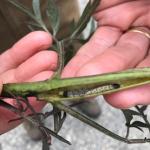
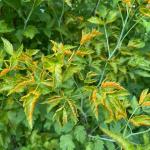 Pests/Problems: The insect pest dominating discussions currently is the spongy moth caterpillar (Lymantria dispar). However, the infestation varies throughout the county. The highest population remains in the south county region, particularly along the New York State border. In any given area, there is a mix of sizes of larvae, from early instar to mid-instar stages. Ballooning of the caterpillars in these larval stages continues as does crawling from one tree to another. The latter stages have not yet been observed. Nevertheless, defoliation is proceeding rapidly with the youngest foliage on oaks, beech, and many other trees and shrubs already mostly consumed. Droppings from the feeding caterpillars are covering vehicles and other surfaces. Caterpillars can be found crawling on all surfaces, not just vegetative. Allergic reactions, mostly in the form of histamine induced skin rashes after exposure to the hairs (setae) of the caterpillars, have been observed. You do not have to have direct contact with the caterpillars to develop a rash as the setae can be blown about in the wind, however sensitivity varies and most individuals do not experience such reactions. Other pests observed during scouting include: leaftiers on gray dogwood (Cornus racemosa) and hydrangeas, woolly beech aphid on copper beech (Fagus sylvatica purpurea), aphids and spider mites on a variety of woody and herbaceous plants, willow leaf beetle (larval stage), and boxelder twig borer. Few diseases have been observed. These include cedar apple rust and apple scab on apples and crabapples, and pachysandra blight on the new growth of pachysandra. Though not on an ornamental plant, orange rust was observed on black raspberry and blackberry. Ticks abound! Take precautions!
Pests/Problems: The insect pest dominating discussions currently is the spongy moth caterpillar (Lymantria dispar). However, the infestation varies throughout the county. The highest population remains in the south county region, particularly along the New York State border. In any given area, there is a mix of sizes of larvae, from early instar to mid-instar stages. Ballooning of the caterpillars in these larval stages continues as does crawling from one tree to another. The latter stages have not yet been observed. Nevertheless, defoliation is proceeding rapidly with the youngest foliage on oaks, beech, and many other trees and shrubs already mostly consumed. Droppings from the feeding caterpillars are covering vehicles and other surfaces. Caterpillars can be found crawling on all surfaces, not just vegetative. Allergic reactions, mostly in the form of histamine induced skin rashes after exposure to the hairs (setae) of the caterpillars, have been observed. You do not have to have direct contact with the caterpillars to develop a rash as the setae can be blown about in the wind, however sensitivity varies and most individuals do not experience such reactions. Other pests observed during scouting include: leaftiers on gray dogwood (Cornus racemosa) and hydrangeas, woolly beech aphid on copper beech (Fagus sylvatica purpurea), aphids and spider mites on a variety of woody and herbaceous plants, willow leaf beetle (larval stage), and boxelder twig borer. Few diseases have been observed. These include cedar apple rust and apple scab on apples and crabapples, and pachysandra blight on the new growth of pachysandra. Though not on an ornamental plant, orange rust was observed on black raspberry and blackberry. Ticks abound! Take precautions!
Regional Scouting Credits
- CAPE COD REGION - Russell Norton, Horticulture and Agriculture Educator with Cape Cod Cooperative Extension, reporting from Barnstable.
- SOUTHEAST REGION - Brian McMahon, Arborist, reporting from the Dighton area.
- NORTH SHORE REGION - Geoffrey Njue, Green Industry Specialist, UMass Extension, reporting from the Long Hill Reservation, Beverly.
- EAST REGION - Kit Ganshaw & Sue Pfeiffer, Horticulturists reporting from the Boston area.
- METRO WEST REGION – Julie Coop, Forester, Massachusetts Department of Conservation & Recreation, reporting from Acton.
- CENTRAL REGION - Mark Richardson, Director of Horticulture reporting from New England Botanic Garden at Tower Hill, Boylston.
- PIONEER VALLEY REGION - Nick Brazee, Plant Pathologist, UMass Extension Plant Diagnostic Lab, reporting from Amherst.
- BERKSHIRE REGION - Ron Kujawski, Horticultural Consultant, reporting from Great Barrington.
Woody Ornamentals
Diseases
Recent pests and pathogens of interest seen in the UMass Extension Plant Diagnostic Lab, a select few:
- White Pine Needle Damage (WPND): Symptoms of WPND are readily visible at this time and will be for the next few weeks. For trees with moderate to severe cases of WPND, one- and two-year-old needles are yellow/brown and prematurely shedding from the canopy. For mature trees, this can amount to a large volume of foliage. Several native fungal needle blight pathogens are responsible for WPND. Peak needle shedding also corresponds with peak fungal sporulation, dispersal and infection of the current season’s (2022) needles as they elongate. During periods of wet weather and nights with high humidity, fungal spores infect the newly developing needles. Despite becoming infected early in the growing season, these needles may not become symptomatic until late spring or early summer in 2023. As older needles are shed and new needles slowly elongate, diseased trees may look extremely thin. For more information, see here: https://ag.umass.edu/landscape/fact-sheets/dieback-of-eastern-white-pine
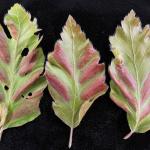
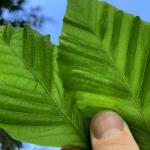 Numerous reports, photos and samples of Beech Leaf Disease (BLD) have been sent to the lab in recent weeks. Disease incidence and severity appears to be highest in Bristol, Plymouth, Norfolk and Essex counties. However, BLD has been confirmed in nearly all counties across the Commonwealth. Continue to scout for foliar symptoms (dark-colored, interveinal banding and convex puckering) and trees with thin canopies that were otherwise healthy in years past. All species and cultivars of beech found in landscape and forest settings are susceptible to attack from the BLD nematode. The damage that is visible now took place in the buds prior to leaf out. The BLD nematode invades the buds in the fall and leaves emerge with symptoms in the spring or the buds are killed and no new growth develops.
Numerous reports, photos and samples of Beech Leaf Disease (BLD) have been sent to the lab in recent weeks. Disease incidence and severity appears to be highest in Bristol, Plymouth, Norfolk and Essex counties. However, BLD has been confirmed in nearly all counties across the Commonwealth. Continue to scout for foliar symptoms (dark-colored, interveinal banding and convex puckering) and trees with thin canopies that were otherwise healthy in years past. All species and cultivars of beech found in landscape and forest settings are susceptible to attack from the BLD nematode. The damage that is visible now took place in the buds prior to leaf out. The BLD nematode invades the buds in the fall and leaves emerge with symptoms in the spring or the buds are killed and no new growth develops.- General decline in the lower canopy of an old Norway spruce (Picea abies) due to needle blight and stem cankering. The tree is approximately 100-years-old and resides in a well-maintained landscape with a 6–8’ radius mulch ring. The tree receives full sun in well-drained, loam soils. The submitted sample had needles infected by Rhizosphaera kalkhoffii and Stigmina lautii and stems cankered by the fungal pathogen Phomopsis. This combination of the needle blight and stem cankering can be very damaging to ornamental spruce, especially when trees are stressed by drought and spider mite infestations.
- Herbicide injury (glyphosate suspected) to rugosa rose (Rosa rugosa). The plants are approximately five-years-old and have been present at the site for two years. The planting bed is steeply sloped and was created because the area was difficult to mow and weedy. This spring, several of the plants exhibited symptoms consistent with herbicide exposure (stunted and deformed foliage and shoots). The injured plants included those on the edge of the bed and in the center. However, some plants in the bed were free of symptoms. There was poison ivy in the area and it’s suspected that glyphosate was used to eradicate it. Only minor amounts of drift are required to cause herbicide injury on roses. The plants were not killed and some are recovering, following fertilization.
- Maple anthracnose, caused by Aureobasidium apocryptum, on Norway maple (Acer platanoides). The tree is roughly 60-years-old and was planted for backyard shade in sandy-loam soils with full sun and limited stresses. This spring, the foliage developed symptoms consistent with anthracnose (dark-colored, angular blotches and marginal leaf blight). The symptoms have been observed in prior years. When severe, maple anthracnose can result in blackened and collapsed foliage that sheds prematurely throughout the canopy. When infections are minor to moderate, the diseased foliage is retained in the canopy, but may shed during warmer and drier periods of the summer.
- White pine needle damage (WPND) on eastern white pine (Pinus strobus) caused by Lophophacidium dooksii. The tree is approximately 15-years-old and resides on a farm in full sun with sandy soils. There is a pile of manure 10’ from the base of the tree, possibly providing some nutrients. Last year, symptoms of WPND developed throughout the entire canopy and appeared again this year. Specifically, yellowing and premature shedding of needles in late spring. While Lophophacidium is a well-known needle pathogen of white pine, it’s not regularly encountered on samples submitted to the UMass Plant Diagnostic Lab. Nonetheless, it’s one of several pathogens that can create chronic needle blight issues for trees in forest and landscape settings.
- Decline of a mature mugo pine (Pinus mugo) due to needle blight caused by Septorioides strobi and Rhizosphaera. The tree is approximately 30-years-old and resides on an old estate in a formal garden. It receives full sun in poorly-drained loam soils. The tree has been pruned aggressively in the past to remove deadwood and borders a brick patio. Needle browning and premature shedding that developed last season has become more advanced this season. Septorioides can cause serious needle shedding on two- and three-needle pines while Rhizosphaera can cause secondary injury on weakened and stressed pines. Old and layered mugo pines that are close to the ground can become very susceptible to disease and insect issues, as is evident here.
Report by Nick Brazee, Plant Pathologist, UMass Extension Plant Diagnostic Lab, UMass Amherst.
Insects
An Update about Neonicotinoid Use in Massachusetts:
Beginning July 1, 2022 systemic insecticide active ingredients known as neonicotinoids will become state restricted use for tree and shrub uses in Massachusetts. If an individual works in the commercial industry (landscapers, arborists, etc.), then a Commercial Certification License is needed. (Example: Category 36 Commercial Certification License, Shade Trees & Ornamentals.) Someone can use a state or federal restricted use pesticide if they have a Commercial Applicators License as long as they are working under the direct supervision of someone with a Commercial Certification. Unlicensed or uncertified individuals will no longer be able to apply neonicotinoids to manage insect pests of trees and shrubs in Massachusetts.
More information is available, here: https://www.mass.gov/service-details/pesticide-newsupdates
Helpful Information from Taryn LaScola-Miner, Director, Crop and Pest Services Division of the MA Department of Agricultural Resources:
“As you know, products that contain neonicotinoids and have certain use patterns will have a classification change from General Use to Restricted Use on July 1, 2022. In order to help inform the manufacturers, dealers, sellers and applicators of which products will be changing from general use to restricted use, the Department has created the list of neonicotinoid products that currently are and will become restricted use beginning July 1st. You may find the list at the link below. Please note that this list is subject to change.
Additionally, MDAR is anticipating that there will be more of a need for companies to follow the Direct Supervision regulations with this change. Therefore, MDAR has updated its Direct Supervision Frequently Asked Questions document as well.
Although an email will be sent to all licensed applicators within the next few weeks as a final reminder of the change, please pass this information along to your members and customers as an effort to make this transition as smooth as possible. If you have any questions, please let me know. Thank you!”
List of Neonicotinoid Products: https://www.mass.gov/doc/list-of-neonicotinoid-pesticides/download
Direct Supervision Frequently Asked Questions: https://www.mass.gov/doc/direct-supervision-frequently-asked-questions-faq/download
Interesting Insects Reported Recently:
-

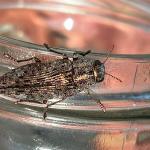
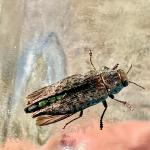 Dicerca spp. Jewel/Wood boring Beetles: Dicerca spp. are in the Family Buprestidae (jewel beetles, flatheaded borers). There are at least 24 species of jewel beetles in the genus Dicerca in North America, 16 of which are present in the northeast. The larvae of these insects have been reared from both conifers and deciduous trees, and the adults of nearly all but one of the species known to North America preferentially select damaged or dying trees to lay their eggs on. (The exception is D. pugionata, whose larvae feed on alder, witch hazel (Hamamelis virginiana), and common ninebark.) As such, these native insects should be preserved and do not require management. They are providing an ecosystem service by aiding in the decomposition of dead or dying plants. Two common species in this genus include Dicerca caudata whose larvae feed on alder and river birch, and D. divaricata whose larvae feed on maple, birch, redbud, ash, hophornbeam, oak, and elm. Finding these beetles is a sign that the tree or shrub has other primary stressors that are causing its decline.
Dicerca spp. Jewel/Wood boring Beetles: Dicerca spp. are in the Family Buprestidae (jewel beetles, flatheaded borers). There are at least 24 species of jewel beetles in the genus Dicerca in North America, 16 of which are present in the northeast. The larvae of these insects have been reared from both conifers and deciduous trees, and the adults of nearly all but one of the species known to North America preferentially select damaged or dying trees to lay their eggs on. (The exception is D. pugionata, whose larvae feed on alder, witch hazel (Hamamelis virginiana), and common ninebark.) As such, these native insects should be preserved and do not require management. They are providing an ecosystem service by aiding in the decomposition of dead or dying plants. Two common species in this genus include Dicerca caudata whose larvae feed on alder and river birch, and D. divaricata whose larvae feed on maple, birch, redbud, ash, hophornbeam, oak, and elm. Finding these beetles is a sign that the tree or shrub has other primary stressors that are causing its decline. -

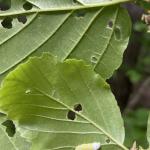
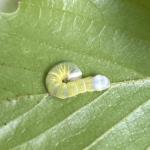 Eyed Mustard & Mustard Sallow Caterpillars: Three species of sallow caterpillar feed on witch hazel in eastern North America. Pyreferra citrombra (eyed mustard sallow), P. hesperidago (mustard sallow), and P. ceromatica. It is very difficult to distinguish between the caterpillars of these three species and Wagner (2005) calls for further study of this genus. Caterpillars may be found on witch hazel, hazel, and hophornbeam in woodlands and forests from Ontario to Georgia. One generation occurs annually with mature caterpillars in May and June. Adults are brown/tan and white winged moths. This genus belongs to the Family Noctuidae (owlet moths). These are native moth caterpillars that while noticeably active some years, are not typically considered pests. Lithophane querquera (shivering pinion) is a species with a caterpillar similar in appearance that is found on apple, ash, cherry, hickory, and oak. Over the long weekend, this species was noticed on witch hazel in Granville State Forest by Dr. Nick Brazee. His excellent photos are included here and his observations discussed above in the Pioneer Valley Region report. Mustard sallow caterpillars were also reported in 2015 on witch hazel in the Berkshires. See report here: https://ag.umass.edu/landscape/landscape-message-jun-12-2015, which states:
Eyed Mustard & Mustard Sallow Caterpillars: Three species of sallow caterpillar feed on witch hazel in eastern North America. Pyreferra citrombra (eyed mustard sallow), P. hesperidago (mustard sallow), and P. ceromatica. It is very difficult to distinguish between the caterpillars of these three species and Wagner (2005) calls for further study of this genus. Caterpillars may be found on witch hazel, hazel, and hophornbeam in woodlands and forests from Ontario to Georgia. One generation occurs annually with mature caterpillars in May and June. Adults are brown/tan and white winged moths. This genus belongs to the Family Noctuidae (owlet moths). These are native moth caterpillars that while noticeably active some years, are not typically considered pests. Lithophane querquera (shivering pinion) is a species with a caterpillar similar in appearance that is found on apple, ash, cherry, hickory, and oak. Over the long weekend, this species was noticed on witch hazel in Granville State Forest by Dr. Nick Brazee. His excellent photos are included here and his observations discussed above in the Pioneer Valley Region report. Mustard sallow caterpillars were also reported in 2015 on witch hazel in the Berkshires. See report here: https://ag.umass.edu/landscape/landscape-message-jun-12-2015, which states:
"A very colorful yellow and white striped caterpillar was found feeding on the foliage of witch hazel. The caterpillar was identified as belonging to the genus Pyreferra. Deb Swanson of Plymouth County believes the species to be Pyreferra hesperidago (mustard sallow caterpillar) which she has seen there in past years."
Insects and Other Arthropods
-
Deer Tick/Blacklegged Tick: Ixodes scapularis adults are active all winter and spring, as they typically are from October through May, and “quest” or search for hosts at any point when daytime temperatures are above freezing. Engorged females survive the winter and will lay 1,500+ eggs in the forest leaf litter beginning around Memorial Day (late May). Larval and nymphal deer ticks may be encountered at this time. Larvae are encountered in New England from roughly May through November, with peak risk reported in August. Nymphs are encountered from April through July with a peak risk reported in June in New England. Nymphs may also be encountered again in October and November. For images of all deer tick life stages, along with an outline of the diseases they carry, visit: https://web.uri.edu/tickencounter/species/blacklegged-tick/ .
Anyone working in the yard and garden should be aware that there is the potential to encounter deer ticks. The deer tick or blacklegged tick can transmit Lyme disease, human babesiosis, human anaplasmosis, and other diseases. Preventative activities, such as daily tick checks, wearing appropriate clothing, and permethrin treatments for clothing (according to label instructions) can aid in reducing the risk that a tick will become attached to your body. If a tick cannot attach and feed, it will not transmit disease. For more information about personal protective measures, visit: https://web.uri.edu/tickencounter/prevention/protect-yourself/
The Center for Agriculture, Food, and the Environment provides a list of potential tick identification and testing resources here: https://ag.umass.edu/resources/tick-testing-resources .
-
Mosquitoes: According to the Massachusetts Bureau of Infectious Disease and Laboratory Science and the Department of Public Health, there are at least 51 different species of mosquito found in Massachusetts. Mosquitoes belong to the Order Diptera (true flies) and the Family Culicidae (mosquitoes). As such, they undergo complete metamorphosis, and possess four major life stages: egg, larva, pupa, and adult. Adult mosquitoes are the only stage that flies and many female mosquitoes only live for 2 weeks (although the life cycle and timing will depend upon the species). Only female mosquitoes bite to take a blood meal, and this is so they can make eggs. Mosquitoes need water to lay their eggs in, so they are often found in wet or damp locations and around plants. Different species prefer different habitats. It is possible to be bitten by a mosquito at any time of the day, and again timing depends upon the species. Many are particularly active from just before dusk, through the night, and until dawn. Mosquito bites are not only itchy and annoying, but they can be associated with greater health risks. Certain mosquitoes vector pathogens that cause diseases such as West Nile virus (WNV) and eastern equine encephalitis (EEE).
For more information about mosquitoes in Massachusetts, visit: https://www.mass.gov/service-details/mosquitoes-in-massachusetts
There are ways to protect yourself against mosquitoes, including wearing long-sleeved shirts and long pants, keeping mosquitoes outside by using tight-fitting window and door screens, and using insect repellents as directed. Products containing the active ingredients DEET, permethrin, IR3535, picaridin, and oil of lemon eucalyptus provide protection against mosquitoes. Be aware that not all of these can be safely used on young children. Read and follow all label instructions for safety and proper use.
For more information about mosquito repellents, visit: https://www.mass.gov/service-details/mosquito-repellents and https://www.cdc.gov/mosquitoes/mosquito-bites/prevent-mosquito-bites.html
-
Wasps/Hornets: Many wasps are predators of other arthropods, including pest insects such as certain caterpillars that feed on trees and shrubs. Adult wasps hunt prey and bring it back to their nest where young are being reared, as food for the immature wasps. A common such example are the paper wasps (Polistes spp.) who rear their young on chewed up insects. They may be seen searching plants for caterpillars and other soft-bodied larvae to feed their young. Paper wasps can sting, and will defend their nests, which are open-celled paper nests that are not covered with a papery “envelope”. These open-celled nests may be seen hanging from eaves or other outdoor building structures. Aerial yellow jackets and hornets create large aerial nests that are covered with a papery shell or “envelope”. Common yellow jacket species include those in the genus Vespula. Dolichovespula maculata is commonly known as the baldfaced hornet, although it is not a true hornet. The European hornet (Vespa crabro) is three times the size of a yellow jacket and may be confused for the Asian giant hornet (Vespa mandarinia). The European hornet is known to Massachusetts, but the Asian giant hornet is not. If you are concerned that you have found or photographed an Asian giant hornet, please report it here: https://massnrc.org/pests/report.aspx . A helpful ID tool, although developed for Texas by the USDA, depicts common look-a-like species that we also have in MA that can be confused for the Asian giant hornet and is found here: https://agrilife.org/lubbock/files/2020/05/Asian_Giant_Hornet_Look-alikes_101_Xanthe_Shirley.pdf . Paper wasps and aerial yellowjackets overwinter as fertilized females (queens) and a single female produces a new nest annually in the late spring. Queens start new nests, lay eggs, and rear new wasps to assist in colony/nest development. Nests are abandoned at the end of the season. Some people are allergic to stinging insects, so care should be taken around wasp/hornet nests. Unlike the European honeybee (Apis mellifera), wasps and hornets do not have barbed stingers, and therefore can sting repeatedly when defending their nests. It is best to avoid them, and if that cannot be done and assistance is needed to remove them, consult a professional.
Woody ornamental insect and non-insect arthropod pests to consider, a selected few:
Invasive Insects & Other Organisms Update:
-
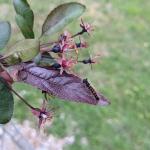 Spongy Moth: Lymantria dispar egg hatch was first reported to UMass Extension by arborists in Great Barrington, MA on 5/5/2022.Since then, the MA Department of Conservation and Recreation has seen eggs hatching in parts of Williamstown, Hancock, Pittsfield, Erving, and Wendell, MA (reported on 5/12/2022). Since then, the MA Department of Conservation and Recreation has seen activity in parts of Williamstown, Hancock, Pittsfield, Erving, and Wendell, MA (reported on 5/12/2022). Additionally, arborists report caterpillar feeding activity in Sheffield, MA. At that location, heavy feeding has been observed on apples (with variation depending on variety) and oak as well as light feeding on Prunus spp., Crataegus spp., and Tilia americana. Light to no defoliation was observed in Sheffield, MA on mulberry, Katsura, hydrangea, pear, Cercis canadensis, and Viburnum nudum. Professionals and property owners working and living in Berkshire County continue to be on high alert as they monitor and manage spongy moth caterpillar feeding. At this time, the caterpillars are still small in size, but by the end of June the extent of their defoliation in western MA should be very apparent as the caterpillars grow.
Spongy Moth: Lymantria dispar egg hatch was first reported to UMass Extension by arborists in Great Barrington, MA on 5/5/2022.Since then, the MA Department of Conservation and Recreation has seen eggs hatching in parts of Williamstown, Hancock, Pittsfield, Erving, and Wendell, MA (reported on 5/12/2022). Since then, the MA Department of Conservation and Recreation has seen activity in parts of Williamstown, Hancock, Pittsfield, Erving, and Wendell, MA (reported on 5/12/2022). Additionally, arborists report caterpillar feeding activity in Sheffield, MA. At that location, heavy feeding has been observed on apples (with variation depending on variety) and oak as well as light feeding on Prunus spp., Crataegus spp., and Tilia americana. Light to no defoliation was observed in Sheffield, MA on mulberry, Katsura, hydrangea, pear, Cercis canadensis, and Viburnum nudum. Professionals and property owners working and living in Berkshire County continue to be on high alert as they monitor and manage spongy moth caterpillar feeding. At this time, the caterpillars are still small in size, but by the end of June the extent of their defoliation in western MA should be very apparent as the caterpillars grow.
If high-value specimen trees in Berkshire County are currently being defoliated by young spongy moth caterpillars, consider applying the reduced risk insecticide Bacillus thuringiensis Kurstaki (Btk) to host plant leaves if caterpillars are still small and actively feeding, but before caterpillars are over ¾ inch in length. Spinosad is an additional reduced risk active ingredient for the management of spongy moth caterpillars. Once spongy moth caterpillars are large (2-3 inches in length) and very noticeable, they are very difficult to manage and will have already done much of their feeding. It is preferable to treat the early instar caterpillars, if chemical management is deemed necessary on ornamental plants in the landscape. Keep in mind that most healthy trees can survive a single year of defoliation, if they do not have other stressors. Specimen trees that were defoliated last year in Berkshire County, that have caterpillars feeding on them again this year, should be prioritized.
Why did the common name for Lymantria dispar change recently? More information is available here: https://entsoc.org/news/press-releases/spongy-moth-approved-new-common-name-lymantria-dispar
To learn more about the life cycle and natural enemies of this insect, visit: https://ag.umass.edu/landscape/education-events/insectxaminer
-
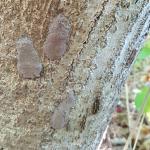 Spotted Lanternfly: (Lycorma delicatula, SLF) is a non-native, invasive insect that feeds on over 103 species of plants, including many trees and shrubs that are important in our landscapes.
Spotted Lanternfly: (Lycorma delicatula, SLF) is a non-native, invasive insect that feeds on over 103 species of plants, including many trees and shrubs that are important in our landscapes.
The MA Department of Agricultural Resources (MDAR) recently published the following press release, urging professionals and the general public to search all nursery stock, particularly maples and crabapples, purchased this year for spotted lanternfly egg masses: https://www.mass.gov/news/state-agricultural-officials-ask-public-to-be-on-alert-for-hatching-of-invasive-spotted-lanternfly-eggs . In particular, the press release warns:
“MDAR recently received reports that nursery stock from SLF-infested areas may have been sent to Massachusetts growers. Due to this, anyone who has recently purchased trees or shrubs or had them planted on their property, particularly maple or crabapple trees, is being asked to inspect the trunk and branches to ensure there are no SLF egg masses or any hitchhiking nymphs, and to report any finds to MDAR. Landscapers and plant nurseries are also being reminded to stay on the lookout for this pest.”
Currently, the only established populations of spotted lanternfly in Massachusetts are in a small area in both Fitchburg and Shrewsbury, MA. Therefore, there is no reason to be preemptively treating for this insect in other areas of Massachusetts. If you suspect you have found spotted lanternfly in additional locations, please report it immediately to MDAR here: https://massnrc.org/pests/slfreport.aspx . If you are living and working in the Fitchburg and Shrewsbury areas, please be vigilant and continue to report anything suspicious.
For More Information:
From UMass Extension:
Check out the InsectXaminer Episode about spotted lanternfly adults and egg masses! Available here: https://ag.umass.edu/landscape/education-events/insectxaminer
Fact Sheet: https://ag.umass.edu/landscape/fact-sheets/spotted-lanternfly
From the MA Department of Agricultural Resources:
Fact Sheet and Map of Locations in MA: https://massnrc.org/pests/pestFAQsheets/spottedlanternfly.html
-
Asian Longhorned Beetle: (Anoplophora glabripennis, ALB) Look for signs of an ALB infestation which include perfectly round exit holes (about the size of a dime), shallow oval or round scars in the bark where a female has chewed an egg site, or sawdust-like frass (excrement) on the ground nearby host trees or caught in between branches. Be advised that other, native insects may create perfectly round exit holes or sawdust-like frass, which can be confused with signs of ALB activity.
The regulated area for Asian longhorned beetle is 110 square miles encompassing Worcester, Shrewsbury, Boylston, West Boylston, and parts of Holden and Auburn. If you believe you have seen damage caused by this insect, such as exit holes or egg sites, on susceptible host trees like maple, please call the Asian Longhorned Beetle Eradication Program office in Worcester, MA at 508-852-8090 or toll free at 1-866-702-9938.
To report an Asian longhorned beetle find online or compare it to common insect look-alikes, visit: http://massnrc.org/pests/albreport.aspx or https://www.aphis.usda.gov/pests-diseases/alb/report .
-
Browntail Moth: Euproctis chrysorrhoea is an invasive insect originating from Europe and first detected in the US in Somerville, MA in 1897. Currently, browntail moth is limited to a small portion of eastern Massachusetts, particularly areas near the coast. Report suspected browntail moth life stages here: https://massnrc.org/pests/pestreports.htm . Due to a persistent outbreak of this insect in Maine since approximately 2016, it is a good idea for us to again familiarize ourselves with this pest. (For more information and the latest updates about the status of this insect in Maine, visit: https://www.maine.gov/dacf/mfs/forest_health/invasive_threats/browntail_moth_info.htm .)
Caution: hairs found on the caterpillar and pupal life stages of this insect can cause a rash similar to poison ivy. Some individuals are very sensitive to browntail moth hairs and may also experience allergic reaction. The chance of interacting with browntail moth hairs increases between May and July, although they could be a problem at any time of year.
The larval or caterpillar stage of this insect is present from August until the following June (spending the winter in webs they create on the tips of host plant twigs). In the fall, groups of caterpillars are found creating webs around a tightly wrapped leaf (covered in bright white silk) where they will overwinter in groups of 25-400. These 2-4 inch long webs can be found on the ends of branches often on apple or red oak. As soon as leaves begin to open in the spring (usually by April), the caterpillars will crawl from their webs to feed on the new leaves. Caterpillars are fully grown around June and spin cocoons in which they pupate. These cocoons are also full of the irritating hairs and should be dealt with extreme caution. Adult moths emerge in July and females lay eggs on the undersides of leaves in masses of 200-400, covering them with hairs from their bodies. (Adults do not typically cause skin rashes.) Eggs hatch around August and September and larvae feed shortly before forming their overwintering webs.
The primary concern with this insect are the poisonous hairs found on the caterpillars. Contact with the caterpillar or its hairs can cause a rash similar to poison ivy in susceptible individuals. If hairs break off and blow around in the wind, they can cause difficulty breathing and headaches. While this insect can act as a defoliator in the larval stage, feeding on the leaves of many deciduous trees and shrubs, this activity may be secondary to concerns about public health risks. Care should be taken to avoid places infested with these caterpillars, exposed skin or clothing should be washed, and the appropriate PPE should be worn if working with these insects. Consult your physician if you have a reaction to the browntail moth.
-
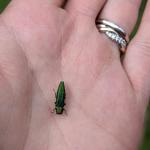 Emerald Ash Borer: (Agrilus planipennis, EAB) has been detected in at least 11 out of the 14 counties in Massachusetts. A map of these locations across the state may be found here: https://ag.umass.edu/fact-sheets/emerald-ash-borer . Additional information about this insect is provided by the MA Department of Conservation and Recreation, here:https://arcg.is/j8TiD .
Emerald Ash Borer: (Agrilus planipennis, EAB) has been detected in at least 11 out of the 14 counties in Massachusetts. A map of these locations across the state may be found here: https://ag.umass.edu/fact-sheets/emerald-ash-borer . Additional information about this insect is provided by the MA Department of Conservation and Recreation, here:https://arcg.is/j8TiD .
This wood-boring beetle readily attacks ash (Fraxinus spp.) including white, green, and black ash and has also been found developing in white fringe tree (Chionanthus virginicus) and has been reported in cultivated olive (Olea europaea). Signs of an EAB infested tree may include D-shaped exit holes in the bark (from adult emergence), “blonding” or lighter coloration of the ash bark from woodpecker feeding (chipping away of the bark as they search for larvae beneath), and serpentine galleries visible through splits in the bark, from larval feeding beneath. It is interesting to note that woodpeckers are capable of eating 30-95% of the emerald ash borer larvae found in a single tree (Murphy et al. 2018). Unfortunately, despite high predation rates, EAB populations continue to grow. However, there is hope that biological control efforts will eventually catch up with the emerald ash borer population and preserve some of our native ash tree species for the future. For an update about the progress of the biological control of emerald ash borer, visit Dr. Joseph Elkinton’s archived 2022 webinar.
-
Jumping Worms: Amynthas spp. earthworms, collectively referred to as “jumping or crazy or snake” worms, overwinter as eggs in tiny, mustard-seed sized cocoons found in the soil or other substrate (ex. compost) that are impossible to remove. The first adults appear in the end of May – June, but the numbers are low and infestations are rarely noticed at that time. It is easy to misidentify earthworms if only immatures found. By August and September, this is when most observations of fully mature jumping worms occur. At that time, snake worms become quite abundant, infestations become very noticeable, and may cause a lot of concern for property owners and managers.
For More Information:
UMass Extension Fact Sheets:
Earthworms in Massachusetts – History, Concerns, and Benefits: https://ag.umass.edu/landscape/fact-sheets/earthworms-in-massachusetts-history-concerns-benefits
Jumping/Crazy/Snake Worms – Amynthas spp.:
https://ag.umass.edu/landscape/fact-sheets/jumpingcrazysnake-worms-amynthas-spp
A Summary of the Information Shared at UMass Extension’s Jumping Worm Conference in January 2022:
https://ag.umass.edu/news-events/highlights/jumping-worms-conference
Tree & Shrub Insect Pests, Continued:
-
Arborvitae Leafminer: In New England and eastern Canada, four species of leafminers are known to infest arborvitae. These include Argyresthia thuiella, A. freyella, A. aureoargentella, and Coleotechnites thujaella. The arborvitae leafminer, A. thuiella, is the most abundant of these and has the greatest known range when compared to the others. (It is also found in the Mid-Atlantic States and as far west as Missouri). Moths of this species appear from mid-June to mid-July and lay their eggs. The damage caused by all of these species is nearly identical. Trees, however, have been reported to lose up to 80% of their foliage due to arborvitae leafminer and still survive. At least 27 species of parasites have been reported as natural enemies of arborvitae leafminers, the most significant of which may be a parasitic wasp (Pentacnemus bucculatricis). Arborvitae leafminer damage causes the tips of shoots and foliage to turn yellow and brown. If infestations are light, prune out infested tips.
-
Azalea Sawflies: There are a few species of sawflies that impact azaleas. Johnson and Lyon's Insects that Feed on Trees and Shrubs mentions three of them. Amauronematus azaleae was first reported in New Hampshire in 1895 and is likely found in most of New England. Adults of this species are black with some white markings and wasp-like. Generally green larvae feed mostly on mollis hybrid azaleas. Remember, sawfly caterpillars have at least enough abdominal prolegs to spell “sawfly” (so 6 or more prolegs). Adults are present in May, and females lay their eggs and then larvae hatch and feed through the end of June. There is one generation per year. Nematus lipovskyi has been reared from swamp azalea (Rhododendron viscosum). Adults of that species have been collected in April (in states to the south) and May (in New England) and larval feeding is predominantly in late April and May in Virginia and June in New England. One generation of this species occurs per year, and most mollis hybrid azaleas can be impacted. A third species, Arge clavicornis, is found as an adult in July and lays its eggs in leaf edges in rows. Larvae are present in August and September. Remember, Bacillus thuringiensis Kurstaki does not manage sawflies.
-
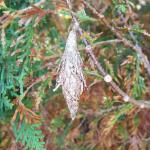 Bagworm: Thyridopteryx ephemeraeformis is a native species of moth whose larvae construct bag-like coverings over themselves with host plant leaves and twigs. This insect overwinters in the egg stage, within the bags of deceased females from last season. Eggs may hatch and young larvae are observed feeding around mid-June, or roughly between 600-900 GDD’s. Now is the time to scout for and remove and destroy overwintering bags. More information can be found here: https://ag.umass.edu/landscape/fact-sheets/bagworm
Bagworm: Thyridopteryx ephemeraeformis is a native species of moth whose larvae construct bag-like coverings over themselves with host plant leaves and twigs. This insect overwinters in the egg stage, within the bags of deceased females from last season. Eggs may hatch and young larvae are observed feeding around mid-June, or roughly between 600-900 GDD’s. Now is the time to scout for and remove and destroy overwintering bags. More information can be found here: https://ag.umass.edu/landscape/fact-sheets/bagworm
-
Boxwood Leafminer: Monarthropalpus flavus partly grown fly larvae overwinter in the leaves of susceptible boxwood. Yellowish mines may be noticeable on the undersides of leaves. This insect grows rapidly in the spring, transforming into an orange-colored pupa. After pupation, adults will emerge and white colored pupal cases may hang down from the underside of leaves where adults have emerged. Adults may be observed swarming hosts between 300-650 GDD’s, or roughly the end of May through June. Most cultivars of Buxus sempervirens and B. microphylla are thought to be susceptible. If installing new boxwoods, resistant cultivars such as ‘Vardar Valley’ and ‘Handsworthiensis’ are good choices at sites where this insect has been a problem.
-
Boxwood Mite: Eurytetranychus buxi overwinter as tiny eggs on boxwood leaves and hatch mid-spring. These mites are tiny (about the size of a period) and difficult to detect. Feeding may cause plants to appear off-color. If management is deemed necessary, the timing for treatment may be between 245-600 GDD’s.
-
Boxwood Psyllid: Psylla buxi feeding can cause cupping of susceptible boxwood leaves. Leaf symptoms/damage may remain on plants for up to two years. English boxwood may be less severely impacted by this pest. While foliar applications may be made between 290-440 GDD’s, the damage caused by this insect is mostly aesthetic. Therefore, typically, management is not necessary.
-
Dogwood Borer: Synanthedon scitula is a species of clearwing moth whose larvae bore not only into dogwood (Cornus), but hosts also include flowering cherry, chestnut, apple, mountain ash, hickory, pecan, willow, birch, bayberry, oak, hazel, myrtle, and others. Kousa dogwood appear to be resistant to this species. Signs include the sloughing of loose bark, brown frass, particularly near bark cracks and wounds, dead branches, and adventitious growth. The timing of adult emergence can be expected when dogwood flower petals are dropping and weigela begins to bloom. Adult moth flights continue from then until September. Emergence in some hosts (ex. apple) appears to be delayed, but this differs depending upon the location in this insect’s range. Eggs are laid singly, or in small groups, on smooth and rough bark. Female moths preferentially lay eggs near wounded bark. After hatch, larvae wander until they find a suitable entrance point into the bark. This includes wounds, scars, or branch crotches. This insect may also be found in twig galls caused by other insects or fungi. Larvae feed on phloem and cambium. Fully grown larvae are white with a light brown head and are approx. ½ inch long. Pheromone traps and lures are useful for determining the timing of adult moth emergence and subsequent management.
-
Dogwood Sawfly: Macremphytus tarsatus has one generation per year. The larvae of the dogwood sawfly overwinter in decaying wood and occasionally compromised structural timber. An overwintering "cell" is created in this soft wood. Pupation occurs in the springtime and adults can take a lengthy time to emerge, roughly between late May and July. 100+ eggs are laid in groups on the underside of leaves. Eggs hatch and the larvae feed gregariously, initially skeletonizing leaves. As the caterpillars grow in size, they are capable of eating the entire leaf with the exception of the midvein. Larval appearance varies greatly throughout instars, so much so that one might mistake them for multiple species. Early instars are translucent and yellow, but as the caterpillars grow they develop black spots (over yellow) and become covered in a white powder-like material. Larvae and their shed skins may resemble bird droppings. Full grown larvae begin to wander in search of a suitable overwintering location. Rotting wood lying on the ground is preferred for this. Foliage of dogwood, especially gray dogwood (Cornus racemosa) may be impacted. Skeletonizes leaves at first, then eats all but the midvein.
-
Eastern Tent Caterpillar: Malacosoma americanum eggs overwinter on host plant twigs. Egg hatch typically occurs when wild cherry leaves begin to unfold and young caterpillars may emerge by late-April through the first two weeks in May (90-190 GDD’s). Susceptible hosts include cherry and crabapple. Other host plants whose leaves are fed upon by this native insect can include apple, ash, birch, willow, maple, oak, poplar, and witch-hazel. Where practical, prune out and remove new eastern tent caterpillar tents before they become larger as the caterpillars continue to feed. Eastern tent caterpillars are large and beginning to wander from their nests in parts of Hampshire County, MA as of 5/30/2022. Eastern tent caterpillars are native to Massachusetts and have many associated natural enemies (parasites and predators) that help regulate populations. Unless these caterpillars are actively defoliating specimen trees in a landscaped setting, we can coexist with this particular herbivore native to our forests.
-
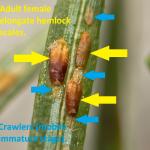 Elongate Hemlock Scale: Fiorinia externa is found on eastern, Carolina, and Japanese hemlock, as well as yew, spruce, and fir. The elongate hemlock scale may overwinter in various life stages and overlap of many developmental stages at any given time can be observed throughout much of the season. Treatments for the crawler, or mobile, stage of this insect may be made in late May through mid-June, or between 360-700 GDD’s, base 50°F. Nitrogen fertilizer applications may make elongate hemlock scale infestations worse.
Elongate Hemlock Scale: Fiorinia externa is found on eastern, Carolina, and Japanese hemlock, as well as yew, spruce, and fir. The elongate hemlock scale may overwinter in various life stages and overlap of many developmental stages at any given time can be observed throughout much of the season. Treatments for the crawler, or mobile, stage of this insect may be made in late May through mid-June, or between 360-700 GDD’s, base 50°F. Nitrogen fertilizer applications may make elongate hemlock scale infestations worse.
- Euonymus Caterpillar: Yponomeuta cagnagella is of European origin and widespread in distribution throughout Europe. It was first reported in North America in Ontario in 1967. The euonymus caterpillars (larvae) feed in groups and envelop the foliage of the host plant in webs as they feed. Hosts include: Euonymus europaeus (tree form), E. kiautschovicus, E. alatus, and E. japonicus. Mature caterpillars are just under an inch in length, creamy yellow-gray in color with black spots and a black head capsule. By late June, these larvae pupate in white, oval-shaped cocoons which are typically oriented together vertically either on host plants or non-hosts in the area. Cocoons can be found in cracks and crevices, or webbed together leaves. The adult moth emerges in late June in most locations. The adult female secretes a gummy substance over her eggs which will harden, making them even more difficult to see. Eggs hatch by mid-August, at which time the tiny larvae prepare to overwinter beneath their eggshell-like covering. These larvae are inactive until the following year, when caterpillars group together to feed on newly emerging leaves, creating a mess of webs as they feed. There is one generation per year. Plants may be partially or entirely defoliated. Management of young, actively feeding caterpillars with Bacillus thuringiensis is possible if deemed necessary, however many species of Euonymus are considered invasive themselves.
Check out Episode 3 of InsectXaminer to see the euonymus caterpillar in action and learn more about its life cycle: https://ag.umass.edu/landscape/education-events/insectxaminer
- Euonymus Scale: Unaspis euonymi is an armored scale that can be found on euonymus, holly, bittersweet, and pachysandra. This insect can cause yellow spotting on leaves, dieback, and distorted bark. For crawlers, early June timing is suggested between 533-820 GDD’s. (Eggs begin to hatch in early June.)
- European Elm Scale: Gossyparia spuria is a type of felt scale. First noted in New York in 1884, this non-native scale is now widespread in North America and is found on native and European elms, but also rarely on hackberry and Zelkova. This insect can cause yellowing of foliage, premature leaf drop, and eventually dieback on its host. Honeydew and thus sooty mold are produced. By the end of June, females will lay eggs that hatch into bright yellow crawlers, which will disperse to the midrib and leaf veins on the underside of elm leaves where they will remain to feed. Crawlers are tiny and magnification is necessary to observe. Natural enemies such as parasitic wasps and predatory insects have been reported as successful in managing this insect.
-
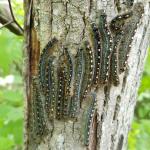 Forest Tent Caterpillar: Malacosoma disstria egg hatch occurs between 192-363 GDD’s, base 50°F, by mid-late May and caterpillars may be active for at least 5-6 weeks following. Susceptible hosts whose leaves are fed on by this insect include oak, birch, ash, maple, elm, poplar, and basswood. This native insect has many natural enemies, including some very effective pathogens that typically regulate populations. However, outbreaks of this insect can occur on occasion.
Forest Tent Caterpillar: Malacosoma disstria egg hatch occurs between 192-363 GDD’s, base 50°F, by mid-late May and caterpillars may be active for at least 5-6 weeks following. Susceptible hosts whose leaves are fed on by this insect include oak, birch, ash, maple, elm, poplar, and basswood. This native insect has many natural enemies, including some very effective pathogens that typically regulate populations. However, outbreaks of this insect can occur on occasion.
- Hemlock Borer: Phaenops (Melanophila) fulvoguttata is in the Family Buprestidae (jewel beetles, flatheaded borers). The hemlock borer belongs to the genus Phaenops whose northeastern species are different enough that they can be relatively easily separated by their coloration and pronotal and elytral sculpturing. As such, it is easier to identify adult beetles by photograph (without observing a specimen with a dissecting microscope and looking at specific features with a dichotomous key). 15
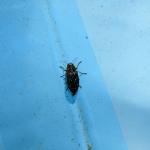 species are known to this genus in North America, and five of those have been recorded in the northeast. Coniferous hosts are the only known larval hosts for this genus, and in the case of P. fulvoguttata, the larvae have been recorded from balsam fir, American larch, white spruce, black spruce, red spruce, eastern white pine, and eastern hemlock. The hemlock borer is considered “infrequently collected”. This native species is likely a secondary pest or decomposer, and not the primary cause of decline in its hosts.
species are known to this genus in North America, and five of those have been recorded in the northeast. Coniferous hosts are the only known larval hosts for this genus, and in the case of P. fulvoguttata, the larvae have been recorded from balsam fir, American larch, white spruce, black spruce, red spruce, eastern white pine, and eastern hemlock. The hemlock borer is considered “infrequently collected”. This native species is likely a secondary pest or decomposer, and not the primary cause of decline in its hosts. -
Hemlock Looper: Two species of geometrid moths in the genus Lambdina are native insects capable of defoliating eastern hemlock, balsam fir, and white spruce. Adult moths lay their eggs on the trunk and limbs of hosts in September and October, and eggs will hatch by late May or early June. (L. fiscellaria caterpillars may be active between 448-707 GDD’s.) Monitor susceptible hosts for small, inch-worm like caterpillars. Where populations are low, no management is necessary. Hemlock loopers have several effective natural enemies.
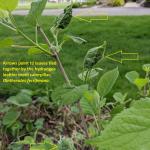
 Hydrangea Leaftier: Olethreutes ferriferana is a moth in the Family Tortricidae whose caterpillars use silk applied to the edges of two newly expanding hydrangea leaves to tie them together to create an envelope-like structure within which they feed. These leaf-envelopes tend to occur near the tips of plant stems and can be very obvious. As a result, the two tied leaves may not fully expand when compared to healthy, non-impacted leaves. Hydrangea leaftier activity was seen on 5/15/2022 in Pittsfield, MA. Many envelope or purse-like structures were seen throughout the plants and could be found from the base to the top of the plant. By gently pulling apart the tied-together leaves, tiny caterpillars were revealed within and able to be mechanically managed by crushing the individual caterpillars.
Hydrangea Leaftier: Olethreutes ferriferana is a moth in the Family Tortricidae whose caterpillars use silk applied to the edges of two newly expanding hydrangea leaves to tie them together to create an envelope-like structure within which they feed. These leaf-envelopes tend to occur near the tips of plant stems and can be very obvious. As a result, the two tied leaves may not fully expand when compared to healthy, non-impacted leaves. Hydrangea leaftier activity was seen on 5/15/2022 in Pittsfield, MA. Many envelope or purse-like structures were seen throughout the plants and could be found from the base to the top of the plant. By gently pulling apart the tied-together leaves, tiny caterpillars were revealed within and able to be mechanically managed by crushing the individual caterpillars.
Caterpillars are green and partially transparent with a black head capsule and a black thoracic shield which is found on the top of the body segment located directly behind the head. Pupation is thought to occur in the ground nearby host plants, so the insect drops to the ground to pupate where it overwinters. Pupation occurs sometime in June. Adults are found in the spring and are small white and brown moths. Eggs are laid on branch tips of various species of hydrangea. Only one generation is known per year. This insect, although creating visible and interesting damage to hydrangea, is not usually considered to be a serious pest – although occasional localized problematic populations have been reported. Removing leaf-envelopes in the early spring or pinching them to kill the caterpillar within can help reduce populations on individual plants.
 Imported Willow Leaf Beetle: Plagiodera versicolora adult beetles overwinter near susceptible hosts. Adult beetles will chew holes and notches in the leaves of willow once they become available. Females lay yellow eggs in clusters on the undersides of leaves. Larvae are slug-like and bluish-green in color. They will feed in clusters and skeletonize the leaves. Most plants can tolerate multiple years of feeding from this insect, and foliage will appear brown. Repeated yearly feeding can occasionally be an issue, in which case management of the young larvae may be necessary. Take care with treatment in areas near water.
Imported Willow Leaf Beetle: Plagiodera versicolora adult beetles overwinter near susceptible hosts. Adult beetles will chew holes and notches in the leaves of willow once they become available. Females lay yellow eggs in clusters on the undersides of leaves. Larvae are slug-like and bluish-green in color. They will feed in clusters and skeletonize the leaves. Most plants can tolerate multiple years of feeding from this insect, and foliage will appear brown. Repeated yearly feeding can occasionally be an issue, in which case management of the young larvae may be necessary. Take care with treatment in areas near water.
Check out Episode 4 of InsectXaminer to see the imported willow leaf beetle in action: https://ag.umass.edu/landscape/education-events/insectxaminer
- Lacebugs: Stephanitis spp. lacebugs such as S. pyriodes can cause severe injury to azalea foliage. S. rhododendri can be common on rhododendron and mountain laurel. S. takeyai has been found developing on Japanese andromeda, leucothoe, styrax, and willow. Stephanitis spp. lace bug activity should be monitored through September. Before populations become too large, treat with a summer rate horticultural oil spray as needed. Be sure to target the undersides of the foliage in order to get proper coverage of the insects. Certain azalea and andromeda cultivars may be less preferred by lace bugs.
-
Lecanium Scales (Oak): Parthenolecanium quercifex overwinters as a second instar nymph on oak twigs. Females will begin feeding and mature in the spring, from mid-April to early May and eggs may be laid between late May and into June. Eggs hatch in June or early July and crawlers migrate to host plant leaves where they spend the summer and migrate as second instars back to host plant twigs in the fall.
-
Lilac Borer: Podosesia syringae is a clearwing moth pest of lilac, privet, fringetree, and ash. (It is also known as the ash borer, not to be confused with the emerald ash borer.) Adults mimic paper wasps. Larvae are wood-boring, and signs and symptoms include branch dieback, holes, and occasionally, sawdust-like frass accumulated on bark. Larvae bore into stems, trunks, and branches, chewing an irregularly shaped entrance hole. Peak adult moth flights may occur in the northern portion of this insect’s range in June and are usually over by August 1st. Pheromone traps can be used to time adult emergence. Adult females lay flattened, oval, and tan eggs that are deposited singly or in clusters on bark crevices, ridges, and sometimes smooth bark; but usually laid in or near wounds in the bark. On average, 395 eggs are laid by each female. After hatch, larvae chew into the bark and feed laterally and then vertically in phloem tissue. Larvae overwinter in tunnels in the final instar and resume feeding in the spring. Adults emerge through a round exit hole (4-5 mm. in diameter). This insect may be targeted between 200-299 GDD’s, base 50°F.
-
Magnolia Scale: Neolecanium cornuparvum overwinters as first instar nymphs which are elliptical, and dark slate gray in color and can usually be found on the undersides of 1 and 2 year old twigs. Nymphs may molt by late April or May and again by early June at which time the scales may be purple in color. Eventually nymphs secrete a white powdery layer of wax over their bodies.
- Rhododendron Borer: Synanthedon rhododendri is one of the smallest of the native clearwing moths. Rhododendrons are preferred hosts, although mountain laurel, and deciduous azaleas can be heavily infested, especially if they are planted in close proximity to rhododendrons. Injury may be first noticed in the fall (leaves lose their sheen, then become pale green, then olive, then chlorotic) and can look similar to drought stress. On branches that seem to be stunted, look at limb crotches, scars, and other irregularities for sawdust stuck on bark or on the ground beneath these areas. In late May and early June, holes may contain pupal shed skins extending halfway out. Moth emergence occurs in the late-spring, early-summer. After mating, female moths seek out suitable egg laying locations (preferring wounded areas or limb crotches). The female lays her eggs and dies. Eggs hatch and larvae tunnel into the inner bark where they feed in tunnels that become packed with reddish frass pellets. By late fall, larvae move to the sapwood where they overwinter and resume feeding by mid-March. Pupation occurs in the spring and there is one generation per year. Prune out and destroy infested branches before late May/June. Monitor for adults in mid-May (192-298 GDD’s, base 50°F).
- Roseslugs: Two species of sawfly can be found on the leaves of roses at this time. These small, caterpillar-like larvae will skeletonize the upper leaf surface and leave a “window-pane” like pattern behind. When present in large numbers, these insects are capable of defoliating their entire host. Caterpillars may feed until roughly mid-June, at which time they will pupate. Management options include an insecticidal soap spray or a product containing spinosad.
-
Spruce Spider Mite: Oligonychus ununguis is a cool-season mite that becomes active in the spring from tiny eggs that have overwintered on host plants. Hosts include spruce, arborvitae, juniper, hemlock, pine, Douglas-fir, and occasionally other conifers. This particular species becomes active in the spring and can feed, develop, and reproduce through roughly June. When hot, dry summer conditions begin, this spider mite will enter a summer-time dormant period (aestivation) until cooler temperatures return in the fall. This particular mite may prefer older needles to newer ones for food. Magnification is required to view spruce spider mite eggs. Tapping host plant branches over white paper may be a useful tool when scouting for spider mite presence. (View with a hand lens.) Spider mite damage may appear on host plant needles as yellow stippling and occasionally fine silk webbing is visible. Be sure to also scout for predatory mite adults and eggs which can help regulate spruce spider mite populations. Avoid broad spectrum chemical management options that kill predatory mite populations, often making spruce spider mite outbreaks worse.
-
Taxus Mealybug: Dysmicoccus wistariae will produce honeydew and lead to sooty mold growth, yellowing of needles, and sparsely foliated plants. Eventual dieback may be possible. This species is commonly associated with taxus in New England, but can be occasionally found on dogwood, rhododendron, Prunus spp., maple, andromeda, and crabapple. These mealybugs are found on stems and branches and particularly like to congregate at branch crotches. Taxus mealybug feeds in the inner bark tissue of the trunk and branches. Adult females are present from June to August and give birth to living young in the summer. Immatures overwinter. A single generation may occur per year in New England, but areas to the south can have multiple generations of this insect. Management may be targeted between 246-618 GDD’s, base 50°F. Horticultural oil and neem oil may be used.
-
Viburnum Leaf Beetle: Pyrrhalta viburni is a beetle in the family Chrysomelidae that is native to Europe, but was found in Massachusetts in 2004. This beetle feeds exclusively on many different species of viburnum, which includes, but is not limited to, susceptible plants such as V. dentatum, V. nudum, V. opulus, V. propinquum, and V. rafinesquianum. Some viburnum have been observed to have varying levels of resistance to this insect, including but not limited to V. bodnantense, V. carlesii, V. davidii, V. plicatum, V. rhytidophyllum, V. setigerum, and V. sieboldii. More information about viburnum leaf beetle may be found at http://www.hort.cornell.edu/vlb/ .
-
White Spotted Pine Sawyer (WSPS): Monochamus scutellatus adults can emerge in late May throughout July, depending on local temperatures. This is a native insect in Massachusetts and is usually not a pest. Larvae develop in weakened or recently dead conifers, particularly eastern white pine (Pinus strobus). However, the white spotted pine sawyer looks very similar to the invasive Asian Longhorned Beetle, Anoplophora glabripennis, ALB. ALB adults do not emerge in Massachusetts until July and August. Beginning in July, look for the key difference between WSPS and ALB adults, which is a white spot in the top center of the wing covers (the scutellum) on the back of the beetle. White spotted pine sawyer will have this white spot, whereas Asian longhorned beetle will not. Both insects can have other white spots on the rest of their wing covers; however, the difference in the color of the scutellum is a key characteristic. See the Asian longhorned beetle entry above for more information about that non-native insect.
Concerned that you may have found an invasive insect or suspicious damage caused by one? Need to report a pest sighting? If so, please visit the Massachusetts Introduced Pests Outreach Project: http://massnrc.org/pests/pestreports.htm .
Reported by Tawny Simisky, Extension Entomologist, UMass Extension Landscape, Nursery, & Urban Forestry Program
Additional Resources
Pesticide License Exams - The MA Dept. of Agricultural Resources (MDAR) is now holding exams online. For more information and how to register, go to: https://www.mass.gov/pesticide-examination-and-licensing.
To receive immediate notification when the next Landscape Message update is posted, join our e-mail list or follow us on Facebook.
For a complete listing of upcoming events, see our upcoming educational events https://ag.umass.edu/landscape/upcoming-events
For commercial growers of greenhouse crops and flowers - Check out UMass Extension's Greenhouse Update website
For professional turf managers - Check out Turf Management Updates
For home gardeners and garden retailers - Check out our home lawn and garden resources.
Diagnostic Services
UMass Laboratory Diagnoses Landscape and Turf Problems - The UMass Extension Plant Diagnostic Lab is available to serve commercial landscape contractors, turf managers, arborists, nurseries and other green industry professionals. It provides woody plant and turf disease analysis, woody plant and turf insect identification, turfgrass identification, weed identification, and offers a report of pest management strategies that are research based, economically sound and environmentally appropriate for the situation. Accurate diagnosis for a turf or landscape problem can often eliminate or reduce the need for pesticide use. For sampling procedures, detailed submission instructions and a list of fees, see Plant Diagnostic Laboratory
Soil and Plant Nutrient Testing - The University of Massachusetts Soil and Plant Nutrient Testing Laboratory is located on the campus of The University of Massachusetts at Amherst. Testing services are available to all. The lab provides test results and recommendations that lead to the wise and economical use of soils and soil amendments. For more information, including current turn-around times, visit the UMass Soil and Plant Nutrient Testing Laboratory web site. The lab is currently accepting new orders for Routine Soil Analysis (including optional Organic Matter, Soluble Salts, and Nitrate testing), Particle Size Analysis, Pre-Sidedress Nitrate (PSNT), and Soilless Media (no other types of soil analyses available at this time). Turnaround time: Please plan for the fact that date of receipt in the lab is affected by weekends, holidays, shipping time, and time for UMass Campus Mail to deliver samples to the lab.
Tick Testing - The UMass Center for Agriculture, Food, and the Environment provides a list of potential tick identification and testing options at: https://ag.umass.edu/resources/tick-testing-resources.
Acknowledgements: UMass Extension gratefully acknowledges the support of the following funding sources for the production of the Landscape Message –
- The Massachusetts Nursery and Landscape Association Fund
- The Massachusetts Department of Conservation and Recreation, Award #ISADCR28219926UMA22A
- Stakeholders like you! The Landscape Message is partially supported by educational program user fees.
